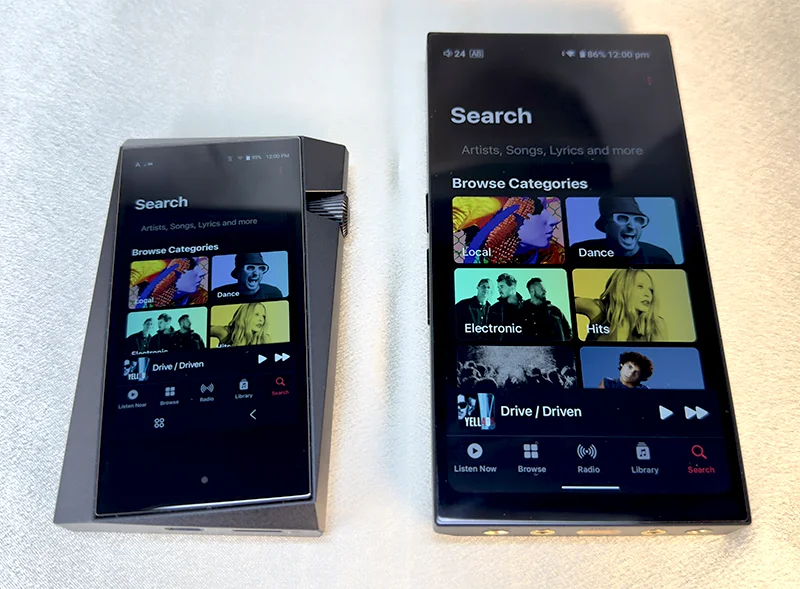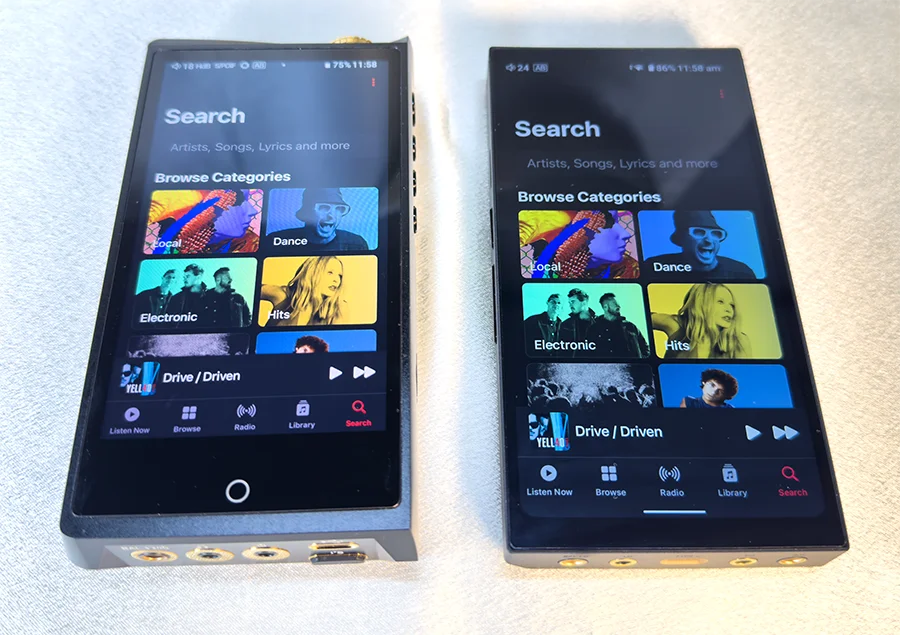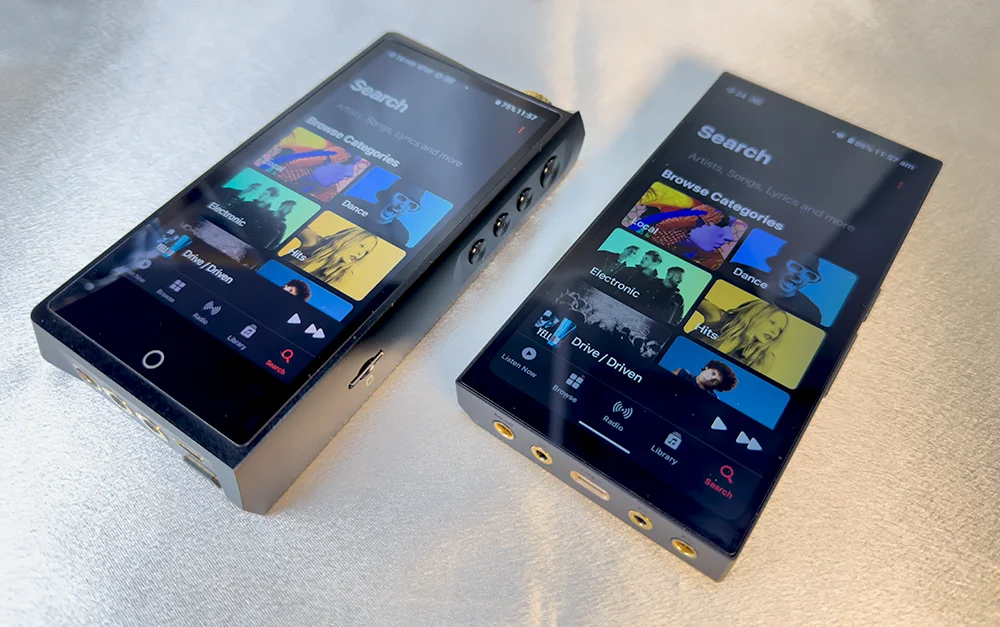Source Comparisons

I used a trio of IEMs to compare the R6P2 with other players on hand, namely the UM MEST MKIII, Noble Spartacus & Penon Turbo. All DAPs were run in their highest-possible gain mode, streaming a mixture of Electronic & Classical music via Apple Music.
Astell & Kern SR35 (USD $799)

Despite being price similarly the SR35 is tiny, dwarfed by the R6P2 which is roughly 100g heavier. As I mentioned in my SR35 review, this is one of the best players on the market for commuting because it absolutely disappears into a pocket and weighs so little, whereas the R6P2 is so much larger it almost feels like a device built for a completely different purpose.
The SR35 is far more comfortable to hold, infinitely more pocketable and its’ high quality volume wheel is much more convenient & pleasurable to use than the R6P2’s volume buttons. Ergonomically there really is no comparison, the SR35 is very hard to beat.
Usability is where the tables are turned. The SR35 is a compromise device, with its’ 3.6″ screen & slow CPU the price of its’ tiny form factor. Even wifi performance is dramatically slower than the R6P2’s, which is far more fluid & responsive cycling through Apple Music menus. In fact the performance gap is probably equally as large as the difference in ergonomics, this time in the R6P2’s favour.

Sonically the R6P2 is a solid step-up from the SR35 in nearly all departments. SR35 bass feels a bit more one-note and isn’t quite as textured, though in terms of quantity sub bass feels more prominent on the SR35 and certainly stands out from the rest of the presentation more.
The SR35 has a greater midrange emphasis & coloration which is something Astell & Kern have been famous for, whereas the R6P2 feels more neutral. I notice the midrange on the SR35 more, whereas the R6P2 emphasises treble a bit more prominently – which means the SR35 could be less fatiguing in long listening sessions, but may come across as more boring or even muddier.

The SR35’s technical performance may also suffer from its’ more muted treble and this is where the Hiby player pulls ahead. The R6P2 has superior dynamics, a blacker background, slightly sharper imaging & higher resolution, and instruments feel like they’re larger.
However if that gives you the impression the R6P2 is light years ahead rest assured that’s definitely is not the case – indeed I find careful A/Bing is required to fully grasp the differences between them, and if portability were my chief concern I’d still choose the SR35 over the R6P2.
Cayin N8ii (USD $3499)

At 442 grams the N8ii feels much heavier than the R6P2, and is twice as thick. Despite the N8ii’s rounded edges making it more comfortable to hold in some ways, it’s a player I’d think twice about using during commutes due to weight & bulk whereas the R6P2 I’d be more comfortable dealing with.
The N8ii’s screen is slightly smaller at 5″ but is brighter, with better contrast & richer colours. The responsiveness of both players is very similar, each providing an extremely fluid Apple Music experience. The N8ii may be slightly faster with marginally quicker wifi performance, but the difference between them feels negligible – a massive win for the R6P2 given the price difference.
I do much prefer the N8ii’s volume wheel to the R6p2’s volume buttons, and also appreciate the N8ii’s Double-tap To Wake function which the R6P2 lacks. However the N8ii’s Line Out is fixed voltage whereas I prefer the R6P2’s variable LO when paired with my Mass Kobo 475 amplifier.

Sonically the N8ii offers greater flexibility, featuring the same Class A/AB & low/mid/hi-gain modes, but adding the superb P+ mode (which almost feels like the addition of a subwoofer) along with Nutube output which imparts a vacuum tube-like colouration – admittedly I generally stick with solid-stage output, but it’s nice having that option.
The N8ii provides some of the highest quality bass of any player on the market, with superb texture and a very elevated amount of quantity – particularly in P+ mode. This is especially beneficial for BA bass IEMs, where the N8ii can add that little bit of extra oomph necessary for their bass output to be satisfying.
The N8ii has a V-shaped tonality and can be fairly bright at times, though you may be surprised to learn I find the N8ii’s greatest sonic strength is its’ tonality – with a midrange in particular that’s extremely organic, making it to my ears one of the most analogue-sounding Android players on the market.

Surprisingly the R6P2 matches the N8ii for dynamics & imaging, and comes shockingly close in resolution. In fact the R6P2’s soundstage is wider as well, though the N8ii’s is undoubtedly deeper.
Where the N8ii pulls ahead is in refinement, with more effortless delivery of nuances and notes that feel more satisfyingly rounded with no loss of detail. Note weight is also better on the N8ii, with a more pronounced sense of fullness & superior layering.
The R6P2 comes remarkably close for a vastly inferior sum however, so which of the two I’d reach for would largely be determined by source/IEM synergy more than anything else.
Page 1 – Introduction, Tech Specs & Battery Life, Ergonomics & Usability
Page 2 – Sound Performance & Technical Performance
Page 3 – Source Comparisons
Page 4 – More Source Comparisons
Page 5 – Conclusion


Great review as always Nick and I agree with so much of what you said. Looking forward to hearing it with my Mass Kobo 475 when it arrives 👍
Thank you Armstrj2! I honestly don’t think anyone can go wrong with the R6P2 unless they absolute insist on owning a smaller player. Definitely the best sonic bang for the buck of any player I’ve tried and good enough to satisfy anyone accustomed to flagship-level sound.
Great review! I’ve been on the fence about getting one of these myself..this review may tip the scale. Appreciate it Nick.
Thank you jeremy, I was skeptical to believe the R6P2 hype myself but it is absolutely the real deal.
Hi, can you a little more about the R6 Pro II + Mass Kobo 475 combination? What exactly is improved and how much ? And how this combo compares, to let’s say, the SP3000 which would be about the same price considering the price of the combo ?
I have a R6 Pro II and I love it, so I’m strongly considering adding the 475 to my chain.
Fantastic review as always ! Thank you!
Marcelo the short answer is – pretty much everything.
Mass Kobo 475 has been my best audio purchase this year. It is simply the best sounding portable amp money can buy, of those I’ve heard anyway, but I’ve heard almost all the good ones.
It expands the stage in all directions, deepens bass, improves resolution significantly, and massively improves control during busy passages – that last benefit is HUGE if you love fast, complex music like I do.
I would take the R6P2 + 475 combo over the SP3000 in a heartbeat, absolutely no contest. Make sure you buy Tamiya Neochamp AA’s – they’re the best sounding brand of batteries we’ve found for the 475, yes there is a sonic difference believe it or not.
Nice, thank you for the answer. I think I will be grabbing one next year then.
Just one more question, how’s the hiss/background noise of the 475 on high sensitivity IEMs ? I have a SoundRhyme SR8 thats like 5 OHMs and the R6 Pro II is the only device I round that is able to handle it without ANY hiss. Did you tried high sensitivity IEMs with the 475 ? If so, is there too much hiss?
Marcelo the 475 on low-gain is almost dead silent, one of the quietest if not the quietest portable amps I’ve owned.
On high-gain the noise floor will go up but I find low-gain is perfectly adequate for IEMs, even those like Storm that are difficult to drive, and use mine in low-gain mode exclusively.